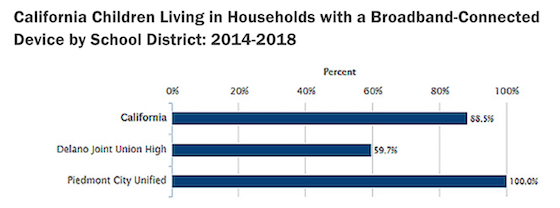 As the school year begins, access to technology, including suitable devices for schoolwork and a sufficient broadband internet connection, is both a requirement for effective learning and a source of division in this new mode of mass education. Educational inequities become more acute when some children lack a dedicated device or have an inadequate internet connection. This digital divide compounds inequities and may have long-term consequences on educational outcomes.
As the school year begins, access to technology, including suitable devices for schoolwork and a sufficient broadband internet connection, is both a requirement for effective learning and a source of division in this new mode of mass education. Educational inequities become more acute when some children lack a dedicated device or have an inadequate internet connection. This digital divide compounds inequities and may have long-term consequences on educational outcomes.
Kidsdata.org now offers data on access to broadband-connected devices under the recently updated Housing Affordability and Resources topic. Access to technology varies greatly across California school districts. In districts with data, as few as 60% of children ages 0-17 live in households connected to high-speed internet through a desktop, laptop, tablet, smartphone, or other computer, in 2014-2018. Read more.
Digital Divide Resources
California Parent Poll: COVID-19 and School Closures reported that 41% of parents felt they did not have enough devices in the home in late March 2020 and 29% lacked reliable internet access. This survey was conducted by Ed Trust-West.
California’s Digital Divide reported that 16% of school-aged children had no internet connection at home in 2017. This survey was conducted by the Public Policy Institute of California.
The Common Sense Census: Media Use by Tweens and Teens, 2019 reported that 73% of lower-income families in the United States with 8 to 18-year-old children had computers compared with 94% of higher-income families. This survey was conducted by Common Sense Media.
